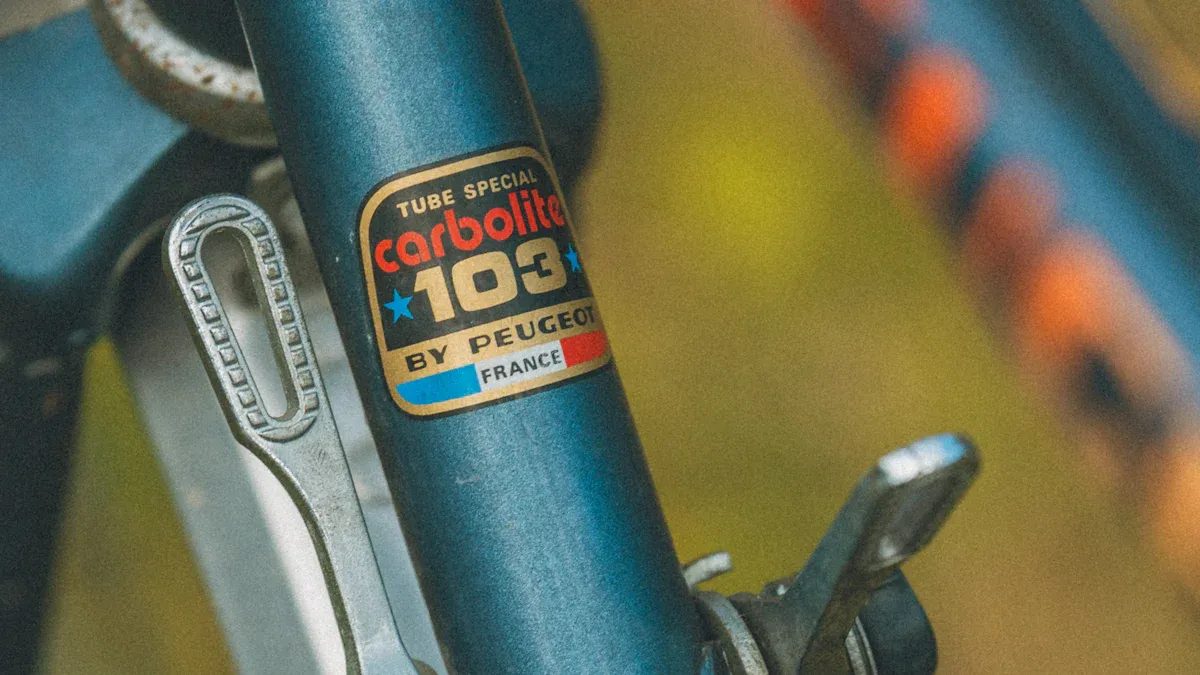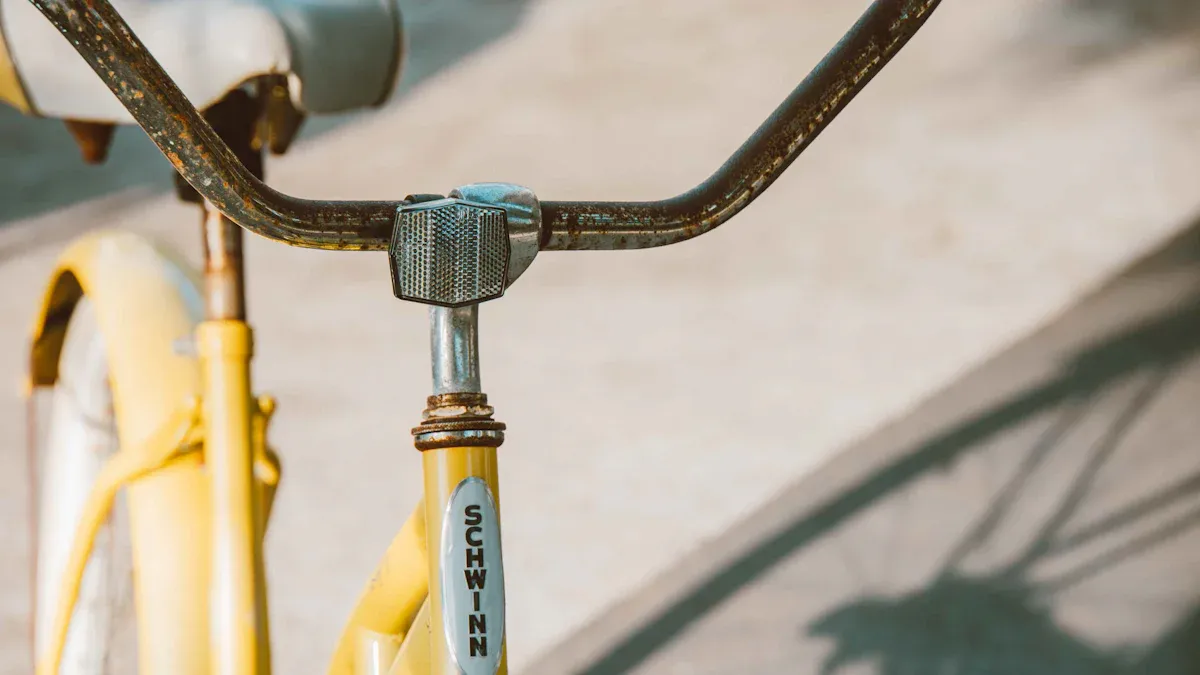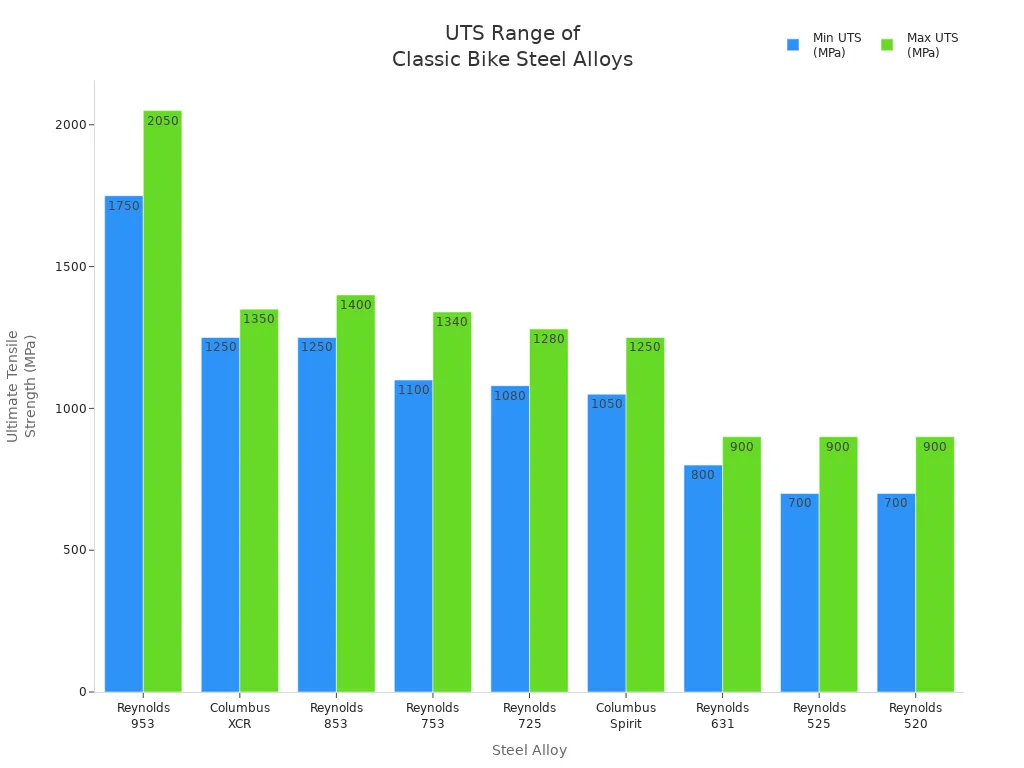
A classic bike frame in 2025 links you to cycling history. Steel is the main part of vintage design. It shapes the comfort and quality you want from classic bikes. Lugs and hand-built work make vintage frames special. Builders use careful hand filing and low-heat brazing. This keeps steel strong and gives you a lighter, tougher bike frame. You feel comfort and a smooth ride each time you pedal a steel frame. Vintage frames are easy to fix and have straight alignment. They also have a look that respects history. These things make vintage bikes known for comfort, quality, and lasting style.
Key Takeaways
Classic bike frames use strong steel tubes. These tubes are joined by hand-shaped lugs. This makes them last long and look classic.
Builders use hand-built methods like brass brazing. This keeps the steel strong. It also makes fixing the bike easier. Your bike can last for many years.
Classic bike geometry has relaxed angles and longer wheelbases. This makes rides stable. It also makes them comfortable and easy to control.
Steel frames give a smooth ride. They are very tough. This makes them good for daily use and long trips.
Picking a classic bike links you to cycling history. You get a special and reliable bike. It looks different from modern bikes.
Steel Bike Frame Materials

Steel and Its Qualities
When you see a classic bike frame, steel is important. Steel makes the frame strong and lasts a long time. Many riders pick steel because it is tough and worth the money. There are many types of steel used in bike frames. Each type has its own special features. Some steel alloys are very strong. Others are made to be more comfortable or to stop rust.
Here is a table that lists the most common steel alloys for bike frames in 2025 and their main features:
Steel Alloy | Ultimate Tensile Strength (UTS) (MPa) | Density (g/cm³) | Special Characteristics & Notes |
|---|---|---|---|
Reynolds 953 | 1750 – 2050 | N/A | Martensitic-aging stainless steel, very high impact strength, fatigue resistance, welded tubing, high strength-to-weight ratio. |
Columbus XCR | 1250 – 1350 | N/A | Martensitic stainless steel with Cr, Mo, Ni; excellent weldability, high fatigue resistance, corrosion resistant, seamless tubing. |
Reynolds 853 | 1250 – 1400 | 7.78 | Air-hardening heat-treated steel; strength increases after welding; allows thin walls; high stiffness and fatigue resistance. |
Reynolds 753 | 1100 – 1340 | N/A | Manganese-moly heat-treated steel; high strength and comfort; requires skilled silver brazing; limited availability. |
Reynolds 725 | 1080 – 1280 | N/A | Heat-treated chrome-moly steel; TIG weldable; good ductility and oxidation resistance. |
Columbus Spirit | 1050 – 1250 | N/A | Niobium alloyed steel; enhanced strength and grain refinement; heat treated; lightweight and reliable. |
Reynolds 631 | 800 – 900 | N/A | Air-hardening, cold-worked steel; durable and comfortable; suitable for touring and MTB; TIG weldable. |
Reynolds 525 | 700 – 900 | N/A | Cold-worked chrome-moly; similar to 531 but non-heat-treated; TIG weldable; lower cost frames. |
Reynolds 520 | 700 – 900 | N/A | Cold-worked chrome-moly; similar to 725 but non-heat-treated; strength varies with cold-working. |
Reynolds 531 | N/A | N/A | Classic manganese-moly cold-worked steel; no longer produced; historically significant in vintage bikes. |
Steel alloys like Reynolds 953 and Columbus XCR are very strong. These alloys help make a bike frame light and tough. Riding a steel bike frame means it can take a lot of use and last for years.

Steel is also a good deal for the price. If you look at the cost of bike frame materials, steel is in the middle. Aluminum frames are cheaper, but they do not last as long. Carbon fiber and titanium frames cost much more. Steel bike frames give you a good mix of price and how long they last. Here is a simple table to compare:
Material | Cost |
|---|---|
Aluminum | Low |
Steel | Moderate |
Carbon Fiber | High |
Titanium | Very High |
Steel is great because it can last a long time. This is called fatigue life. If you take care of a steel bike frame, it can last for many years. Steel and titanium have a fatigue limit. If you keep the stress low, the frame can last almost forever. Aluminum does not have this limit. It will break after many uses, even if you are careful. Still, a good aluminum frame can last a long time for most people.
Tip: If you want a bike frame that will last for many years, steel is a smart pick. It can handle daily rides and rough roads.
Some people think steel frames give a smoother ride. Tests show that the seatpost and tires matter more for comfort. Steel frames are stiff and do not bend much up and down. The comfort you feel mostly comes from your seatpost and tires, not the steel frame.
Lugs and Craftsmanship
Lugs are important for making a classic bike frame special. Lugs are connectors that join the tubes of a steel bike frame. You see lugs on old and handmade bikes. They give the frame a classic look and let the tubes be thinner. This makes the frame lighter and sometimes a bit more flexible, which some riders like.
When you look at a lugged steel bike frame, you see smooth joints and nice shapes. Lugs help spread out the stress where the tubes meet. This keeps the frame strong and helps it last longer. Lugs also make fixing the frame easier. If a tube breaks, you can replace it without throwing away the whole frame.
Hand-built work makes a classic bike frame different from factory bikes. Skilled builders use careful brazing or welding to join the tubes and lugs. They check every detail, like how straight the tubes are and how smooth the joints look. This careful work gives you a bike frame that is both pretty and strong.
Hand-built steel bike frames can become worth more over time. People like the skill and time put into each frame. Old bikes with hand-built frames keep their value and sometimes go up in price. You get a bike frame that is strong, reliable, and a part of cycling history.
Note: If you want a bike frame with tradition, strength, and beauty, pick one with lugs and hand-built work. These frames give you a special mix of style and performance.
Classic Bike Frame Construction

Hand-Built Techniques
You can spot a true vintage bike by the way builders shape and join the steel tubes. Hand-built techniques give each bike frame its own character and strength. In 2025, you see several methods that builders use to create vintage bikes:
Lugged construction: Builders join steel tubes with lugs and silver alloy brazing rods. This method gives you strong joints and a classic look. You find this style on many vintage bikes.
Fillet brazing (lug-less construction): Builders use melted bronze or silver to join tubes without lugs. This lets them shape the frame in new ways and create smooth, flowing joints. Many vintage-style bicycles use this method for a unique look.
TIG welding: This modern method uses an inert gas shield to make clean, strong welds. You see TIG welding on some steel frames, but it is less common on vintage bikes.
CNC-machined or 3D-printed lugs: Some builders use new technology to make custom lugs. These lugs fit perfectly and add strength to the bike frame.
Niche materials: A few hand-built frames use wood or linen. These are rare, but they show how creative builders can get with vintage bikes.
Hand-built techniques let you work closely with a builder. You can choose the tube size, shape, and even the type of steel. This means your vintage bike fits your riding style and body. You get a bike frame that feels just right and stands out from mass-produced bikes. Each vintage bike becomes a one-of-a-kind machine, built for you and your vintage cycling feel.
Brass Brazing and Lugs
Brass brazing is a key part of vintage bike frame building. Builders heat the steel tubes to about 1,800°F. This is much lower than welding, which can reach 3,500°F. Lower heat keeps the steel strong and stops it from getting too soft. You get a bike frame that lasts longer and resists fatigue.
Brass brazing spreads the load over a larger area. This lets builders use thinner steel tubes without making the frame weak. If you crash or damage your vintage bike, repairs are easier. You can replace a tube without throwing away the whole frame. Brazed joints also look smooth and beautiful, which is why many vintage bikes have them.
Lugs play a big role in vintage bike frames. Lugs are metal sleeves that connect the steel tubes. Builders often use investment cast lugs. These start out thick and plain, but skilled builders thin and shape them by hand. They turn simple lugs into works of art. Thinning the edges keeps the frame light, while the thick parts at the joints keep it strong.
Lugs make the joints stronger by spreading out the stress. This helps your vintage bike last longer and resist cracks.
Brazing with lugs uses less heat than welding. This means the steel keeps its strength and does not get damaged.
If your vintage bike needs fixing, lugs make it easy to swap out a tube.
Studies show that lugged joints often last longer and handle more stress than welded or fillet-brazed joints.
Lugs give builders a chance to add artistic touches. You see fancy shapes and cutouts on many vintage bikes.
You notice that every vintage bike frame tells a story. The careful welds, the smooth brass fillets, and the hand-shaped lugs all show the builder’s skill. These details set vintage bikes apart from modern, mass-produced frames. You get a bike frame that is strong, beautiful, and full of history.
Bike Geometry and Design
Classic Geometry Features
Classic bike frames have some special shapes. They use relaxed angles and longer wheelbases. The head tube leans back more than on other bikes. This helps you control the bike better, even when going fast or downhill. You feel more stable and less likely to fall over. Longer wheelbases spread the wheels farther apart. This makes it easier to balance, even on bumpy roads or with extra weight.
Classic bikes also have a flat top tube and a lower front end. Bikes like the Colnago Master show this style. The design lets you ride with no hands and feel steady in turns. The bottom bracket is higher, so you can go over bumps without hitting your pedals. All these features help you feel comfortable and sure on long rides.
If you want a bike that feels steady and smooth, classic bike geometry is a smart pick. It is easy to handle and stays comfy for hours.
Timeless Design Elements
Classic bike frames look good because of their simple style. They have clean lines and shapes that are not too busy. Builders use strong steel and shiny chrome parts. These last a long time and keep looking nice. The design does not follow trends, so your bike always looks cool. You might see things like hidden cables and crossed seatstays. These details make the bike work better and look nicer.
Classic bike geometry is made for balance and comfort. The frame fits your body and gives you a natural way to sit. You get a comfy seat and handlebars that feel right. The wheels, often 26 inches, help you ride steady and turn easily. Every part of the bike is made to give you a smooth ride and last a long time.
Classic bike geometry uses:
Relaxed angles for comfort and stability.
Longer wheelbases for better balance.
Flat top tubes for a classic look.
Good materials for strength.
Simple lines for a timeless style.
Classic bike geometry and design give you comfort, stability, and style. These things make your bike fun to ride and nice to look at every year. The way your bike feels comes from careful work on every part of the frame.
Ride Quality and Durability
Performance and Longevity
When you ride a classic bike frame, you notice how it feels. Many riders say steel frames soak up bumps better. This makes your ride more comfortable. Classic frames can help you ride longer without getting tired. Some people think carbon and aluminum frames are better for racing. These frames are lighter and feel stiffer. But the difference in ride feel is hard to prove. Most people just share what they feel, not what tests show.
Riders often say steel frames give a smoother ride.
Modern frames are made for speed and stiffness in races.
People still argue about which frame is best. There is no clear answer.
Steel frames are known for lasting a long time. Chromoly steel does not wear out fast. It can last for many years. If steel gets damaged, you can fix it. Aluminum frames do not last as long and can break without warning. Titanium frames last even longer and do not rust, but they cost a lot. Carbon fiber frames are strong and light, but hard to fix if broken.
Tip: If you want a bike for trips or adventure, pick steel. Steel frames are strong and dependable. You can carry heavy bags and still ride in comfort.
How long your bike frame lasts depends on a few things:
Do not hit your frame too hard. Keep stress low so it lasts longer.
Pick frames made with good materials and careful work. These frames last longer and work better.
Buy frames from brands you trust. Good brands make bikes that last.
Frame Condition Matters
How your classic bike frame looks and works is important. It affects safety and how much it is worth. Collectors pay more for frames that are still original. If you change parts, your bike might work better. But it could be worth less money. For fancy old bikes, keeping the first parts is important.
Rust, cracks, and crash damage are common problems.
Steel frames bend before they break, so they are safer than aluminum. Aluminum can snap without warning.
Carbon fiber frames can hide damage. You need to check them closely.
Weak spots are at dropouts, fork crowns, and where cables go in.
Check your bike often to find problems early. If you see rust or cracks, fix them fast. This keeps your bike safe and in good shape. Sometimes, selling parts one by one is worth more than selling the whole bike.
Note: Always look over your frame before you ride. Safety is most important, especially with old bikes.
A classic frame that is cared for works well and feels good. You get to enjoy the bike’s history and style. With the right care, your bike will last for many years.
Classic vs. Modern Bike Frame
Materials and Methods
There are big differences between classic and modern bike frames. Classic frames use steel tubes joined with lugs and brazing. Builders fit the tubes into thick lugs and heat them to join. This way, the tubes can be lighter and repairs are easier. Chromoly steel is common in old bikes. You might see butted tubing, which means the tube is thinner in the middle and thicker at the ends. This helps make the frame strong but not too heavy.
Modern frames often use aluminum alloys. TIG welding joins the tubes together. Aluminum frames have big tubes with thin walls. This makes them stiff and light, but sometimes less comfy. Some modern frames use titanium or carbon fiber. Titanium is strong and light. Carbon fiber is even lighter and can be shaped for speed. Modern frames focus on being fast, light, and stiff. Sometimes, this means they are not as comfortable.
Modern frames are made in factories with machines. This gives you very exact and even quality. Classic frames are hand-built, so the builder’s skill matters a lot. This can make the quality different from one frame to another. Here is a table that compares the two ways:
Factor | Traditional Construction | Modern Construction Techniques |
|---|---|---|
Quality and Precision | The builder’s skill affects quality, so it can change and sometimes needs fixing. | Factory machines make frames with high accuracy and even quality. |
Modern frames use new materials like carbon and titanium. These give better performance. Classic frames use steel and old methods. They last a long time and look classic.
Why Riders Choose Classic
You may wonder why people still pick classic bikes in 2025. Steel frames give a comfy ride. They soak up bumps and do not feel as stiff as aluminum or carbon. Many riders say steel frames help them ride longer without getting tired. You get a smooth ride and feel less sore.
Nostalgia is important too. Some people remember riding old bikes as kids. You might want a bike that reminds you of cycling history. Younger riders like classic bikes because they cost less and are easy to fix. You can fix up an old frame and learn about how it rides.
Online groups help people find and talk about vintage bikes. People of all ages enjoy riding these bikes. Some riders paint new bikes with old colors and styles. This mixes new speed with old looks. You feel proud to own a bike with a story.
Steel frames in old bikes are comfy and last a long time. Aluminum and carbon frames are made for speed and stiffness. Titanium frames are strong and light. You pick a classic frame for its ride, style, and history. Vintage bikes let you enjoy simple parts and fixing things yourself. You join a group that loves old bikes and good rides.
A classic bike frame in 2025 is easy to spot. It has steel tubes and lugs shaped by hand. Builders use old methods that make bikes last a long time. Vintage bikes are special because of this careful work. When you look for a vintage frame, check the tubes. Make sure they are straight and not bent. Look at the welds to see if they are smooth. Check for original parts and details too. Use this table to help you find the best vintage bikes:
What to Check | Why It Matters |
|---|---|
Steel and Lugs | Strong, easy to fix, classic style |
One-of-a-kind, tough, lasts many years | |
Frame Geometry | Feels good and safe to ride |
Condition | No rust, cracks, or hidden problems |
Vintage bikes are more than just something to ride. They remind you of the past and are part of cycling history.
FAQ
What makes a vintage bike frame different from a modern frame?
Vintage frames use steel and lugs. Modern frames use carbon, aluminum, or titanium. Vintage bikes connect you to cycling history. They have classic shapes and hand-built touches. Modern frames are made for speed and light weight.
Is carbon better than steel for bike frames?
Carbon frames are lighter and stiffer. Steel frames last longer and feel smoother. Carbon is best for racing. Steel is good for daily rides and vintage style. You pick what fits your needs and how you ride.
Why do riders still choose aluminum frames?
Aluminum costs less and is light. It does not rust and works for many bikes. You see aluminum in road, mountain, and city bikes. Aluminum frames are a good deal and easy to fix.
How does titanium compare to other materials?
Titanium frames can last your whole life. Titanium does not rust and feels smooth. It weighs less than steel but more than carbon. Titanium costs more, but it gives comfort and strength.
Can you repair a vintage frame made from steel, aluminum, carbon, or titanium?
Steel and titanium frames are easy to fix. Aluminum needs special tools to repair. Carbon frames need an expert to fix them. Check for cracks and rust often. Take care of your vintage bike to keep it safe and strong.
Tip: Always check your frame before you ride. This keeps you safe and helps you enjoy your bike’s history.
See Also
The Continued Importance Of Steel Road Bikes In 2025
Carbon Frames Remain Cyclists’ Preferred Option In 2025
New Advances In Motorized Bike Frames To Watch In 2025
A Guide To Comparing Carbon Race Frames For Best Performance
Decades Of Craftsmanship And Innovation In Steel Bike Frames
